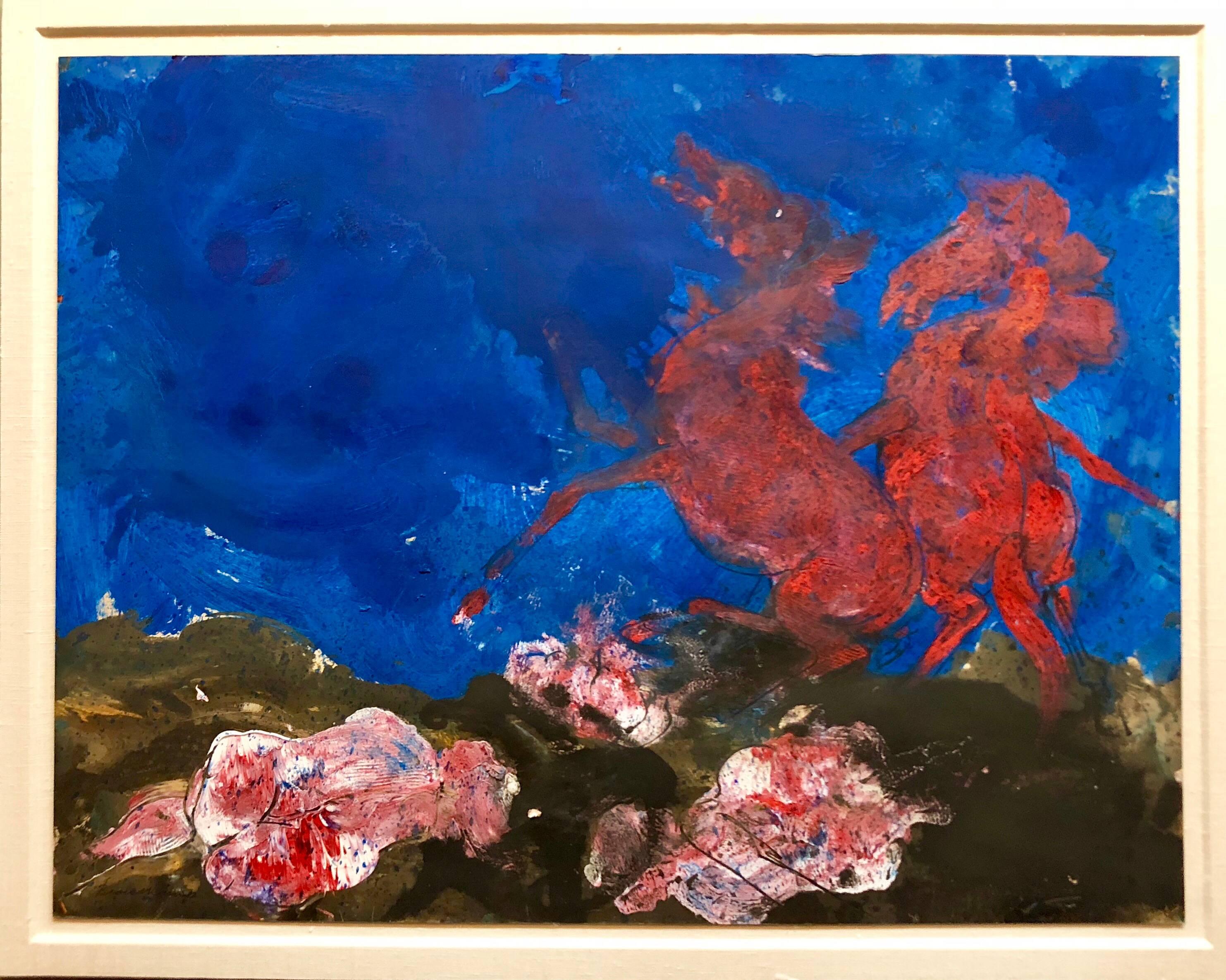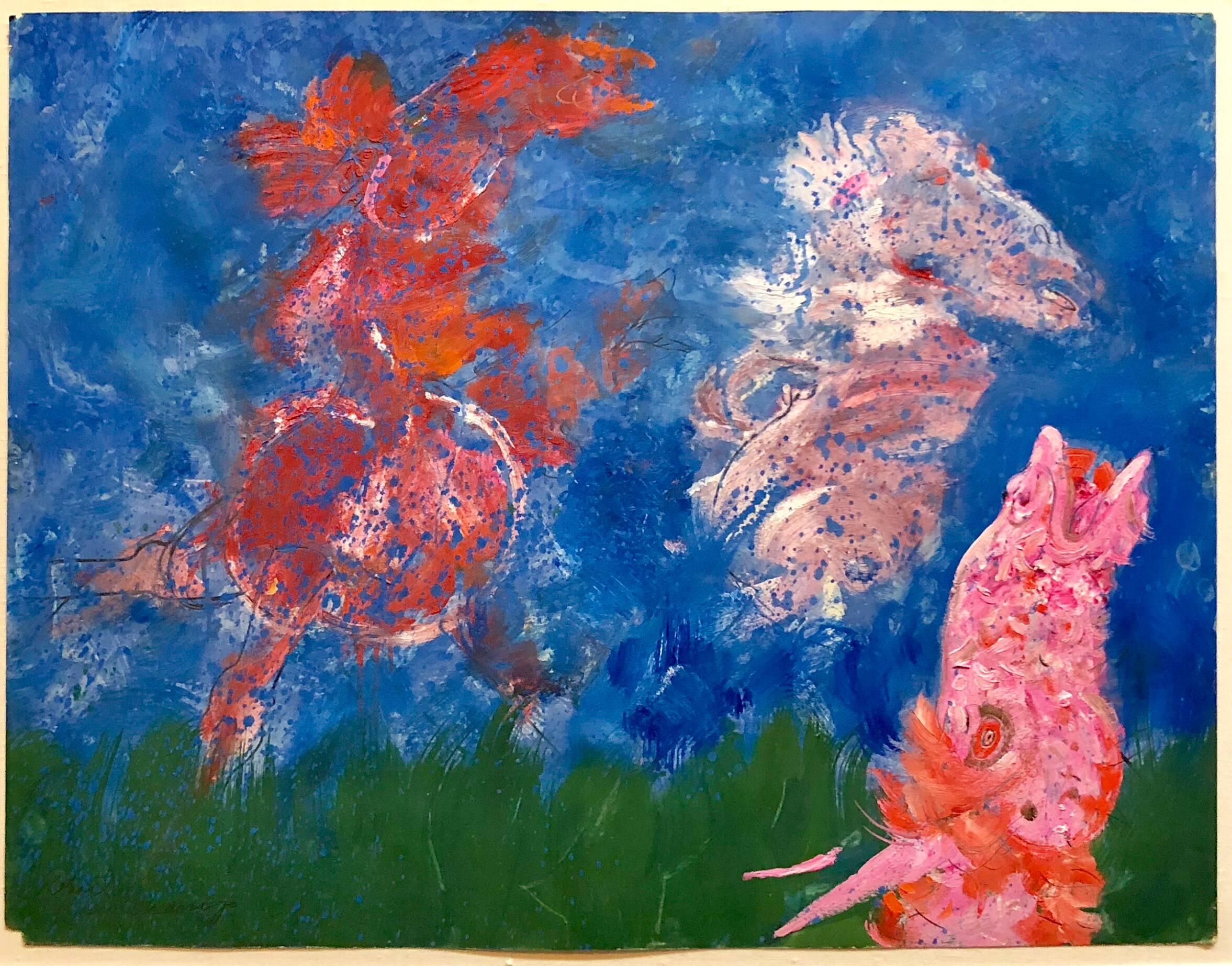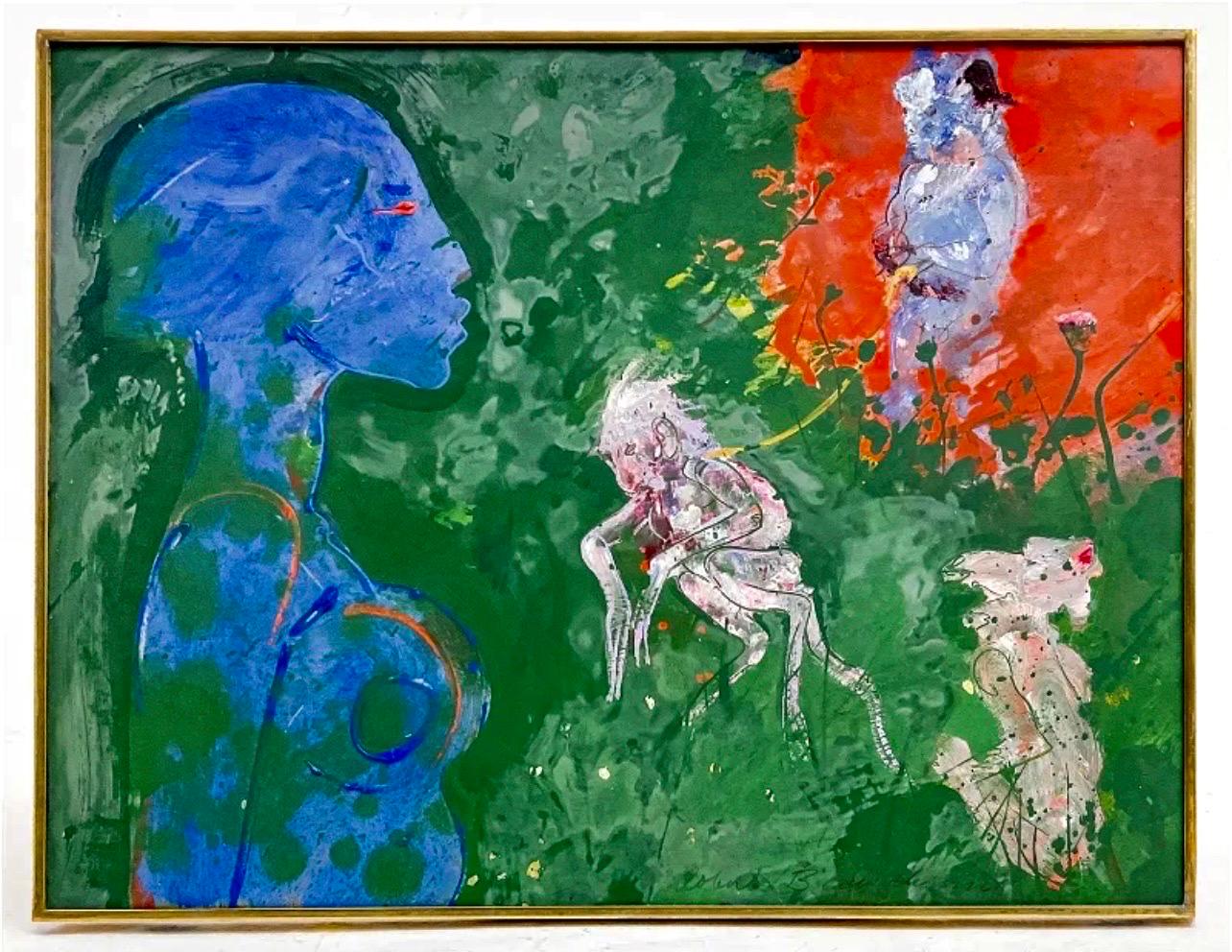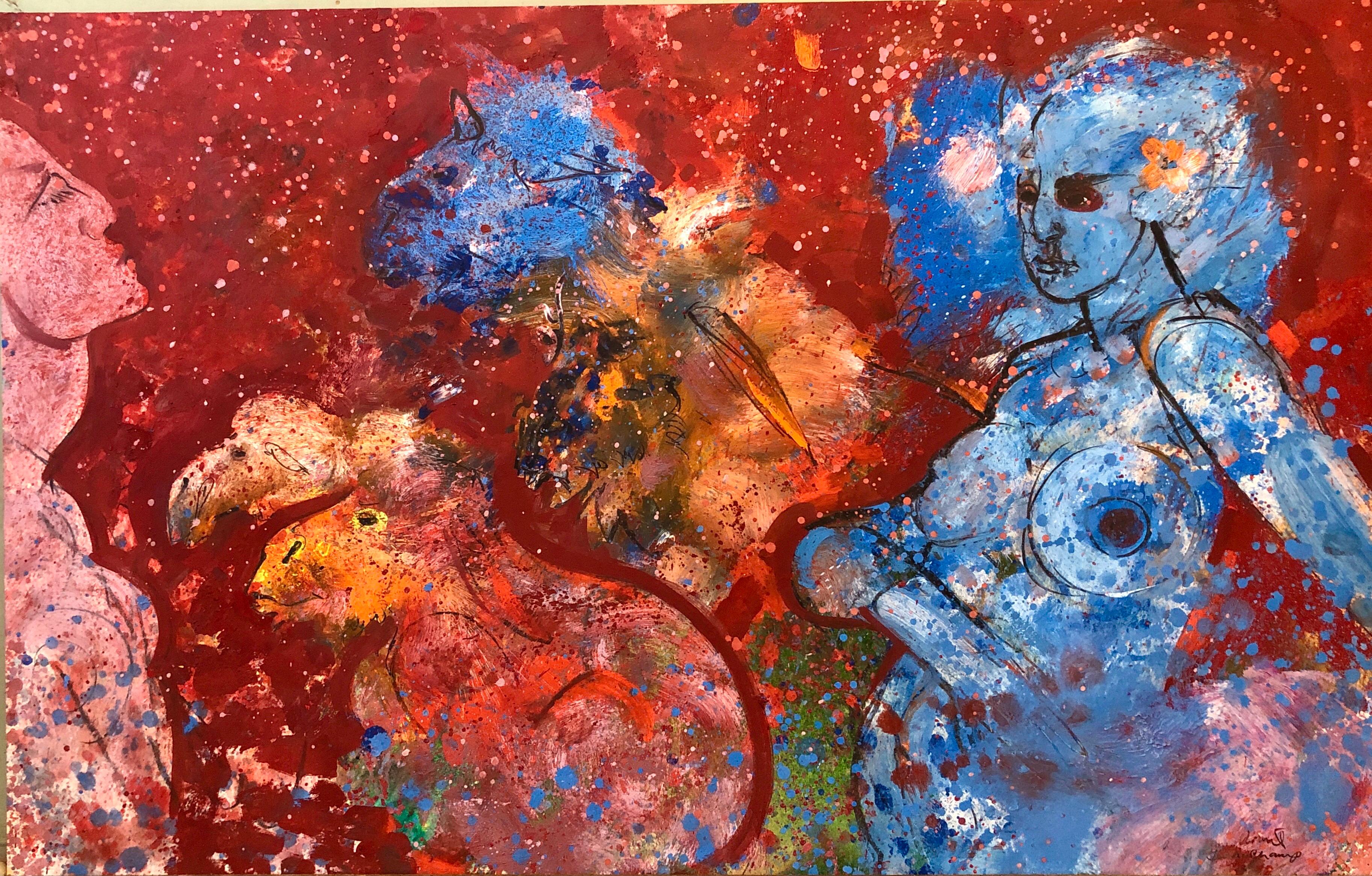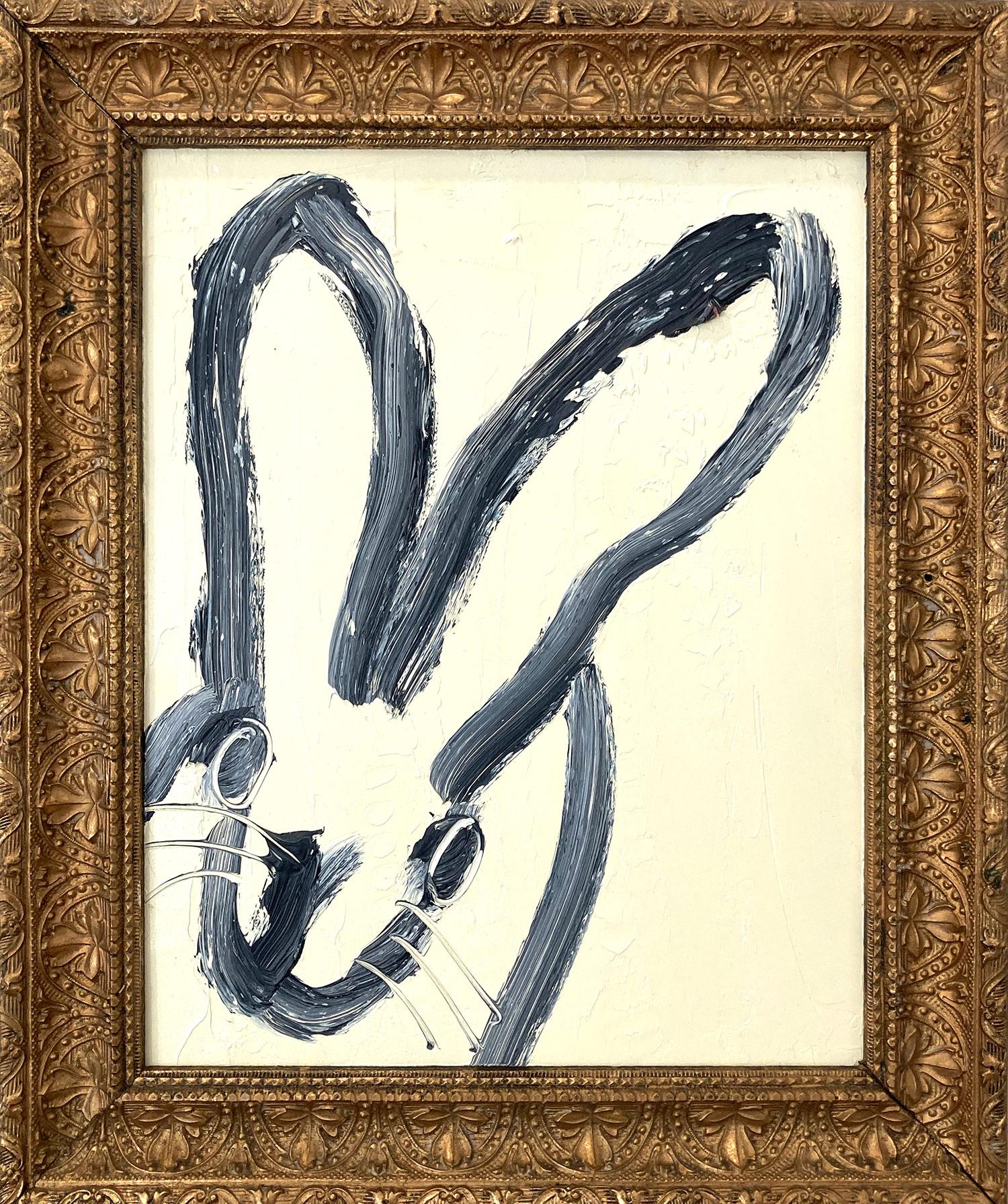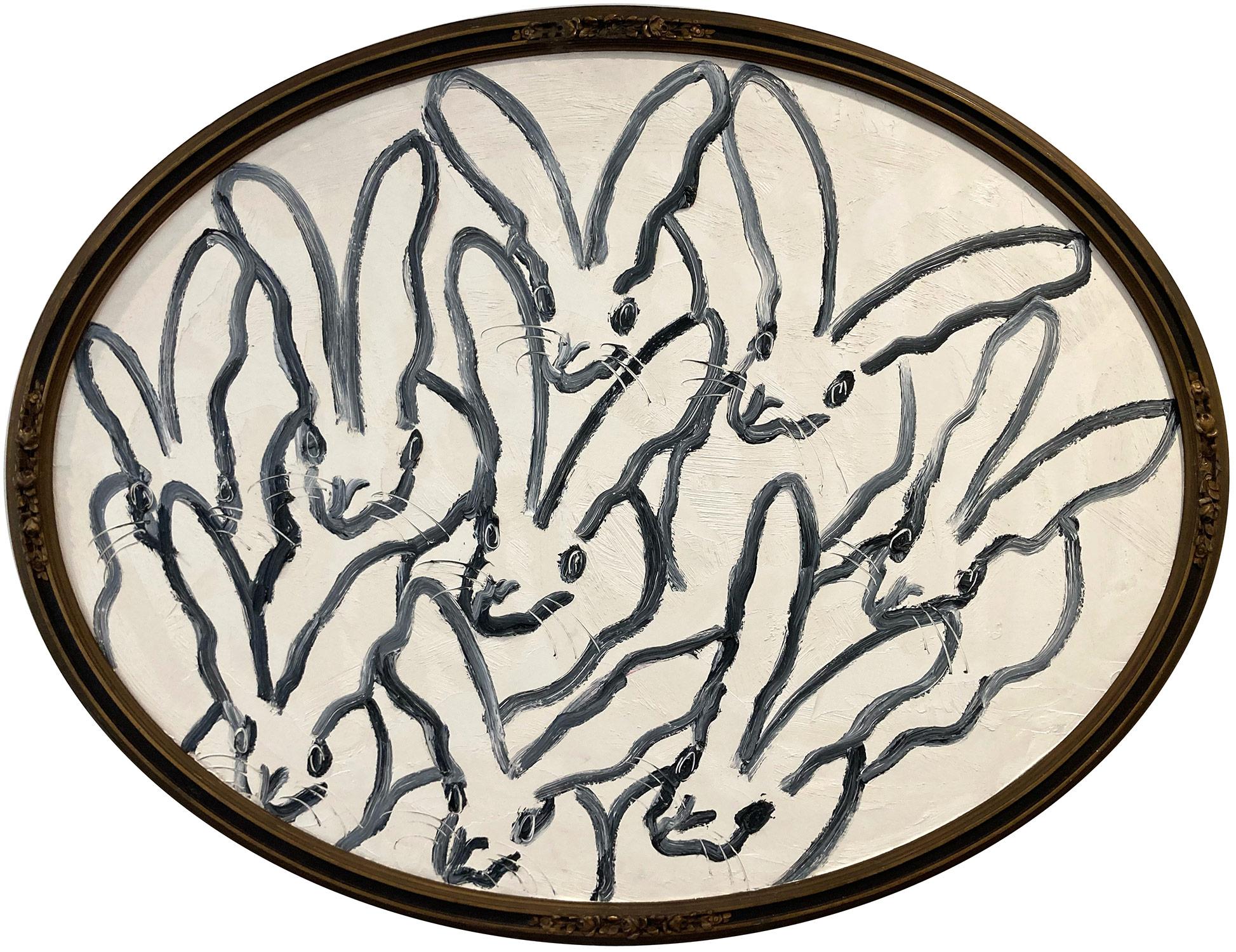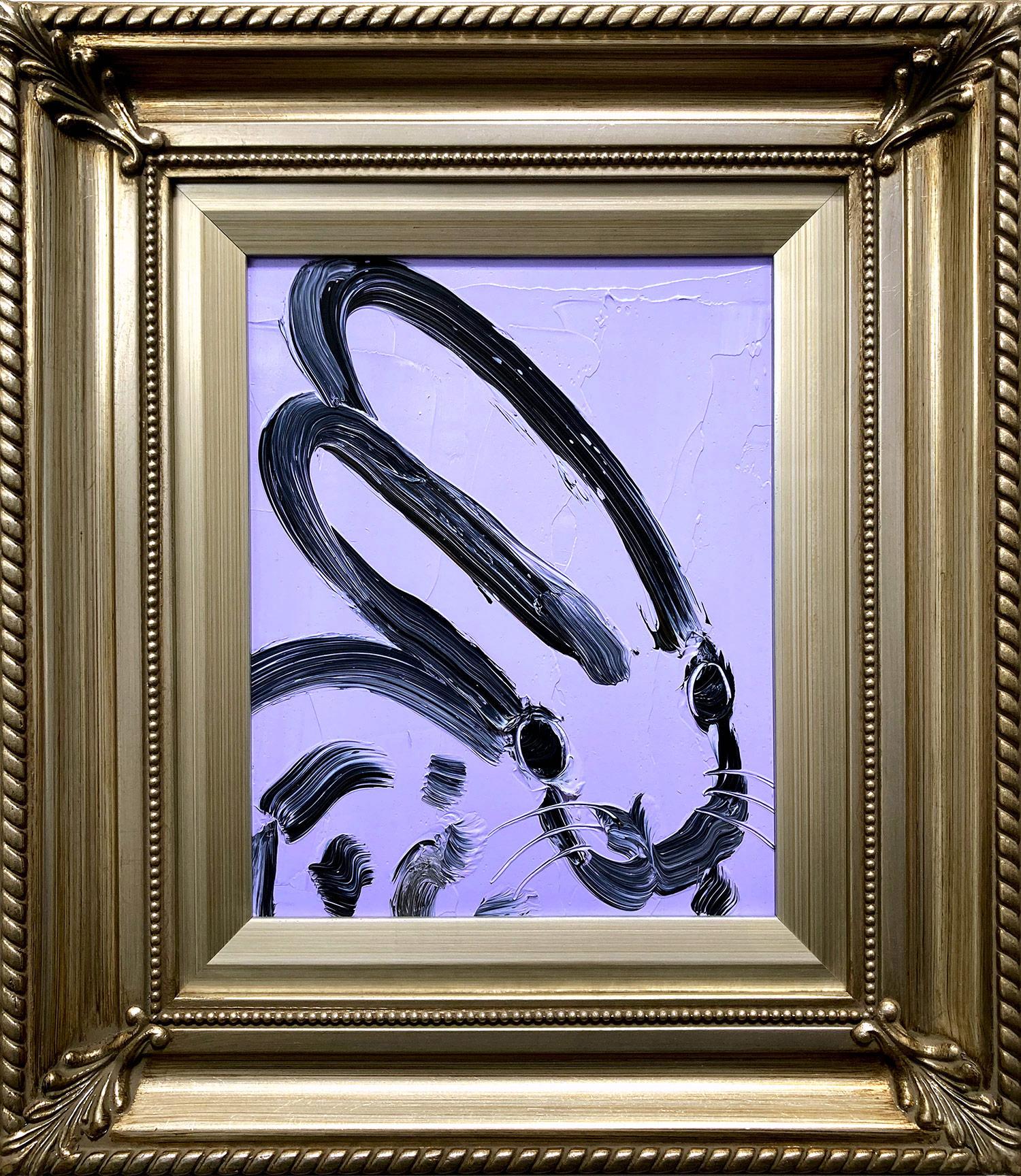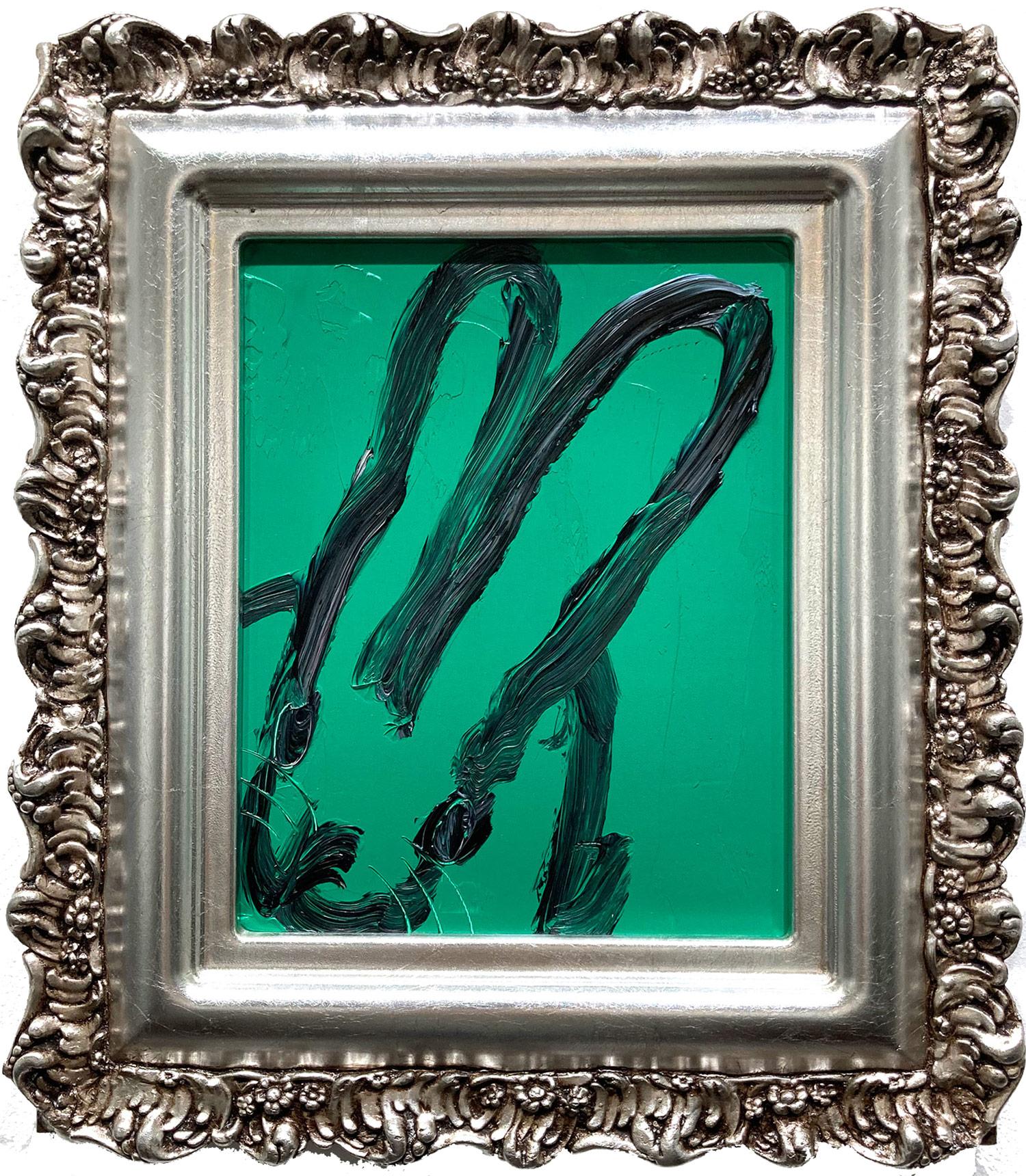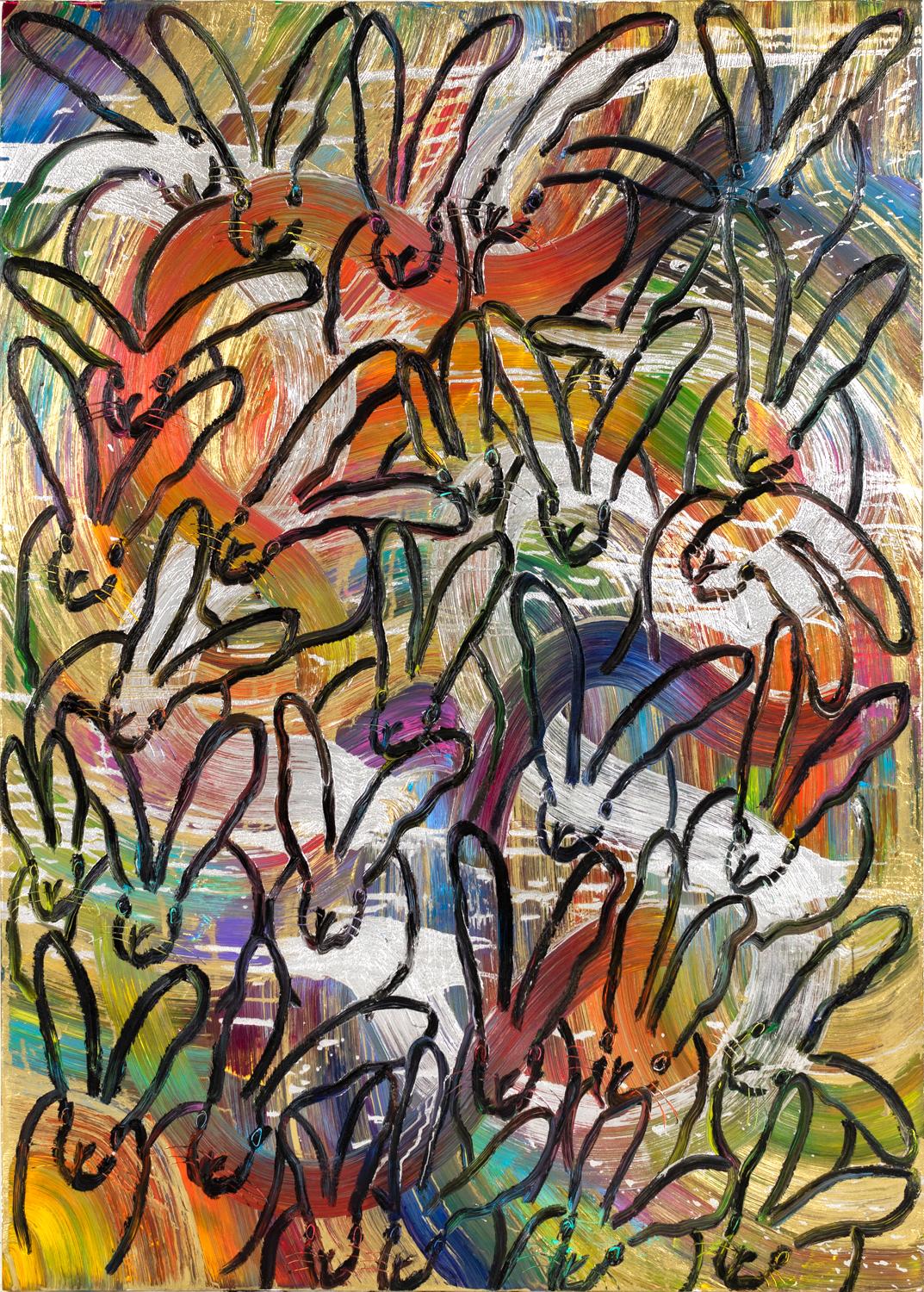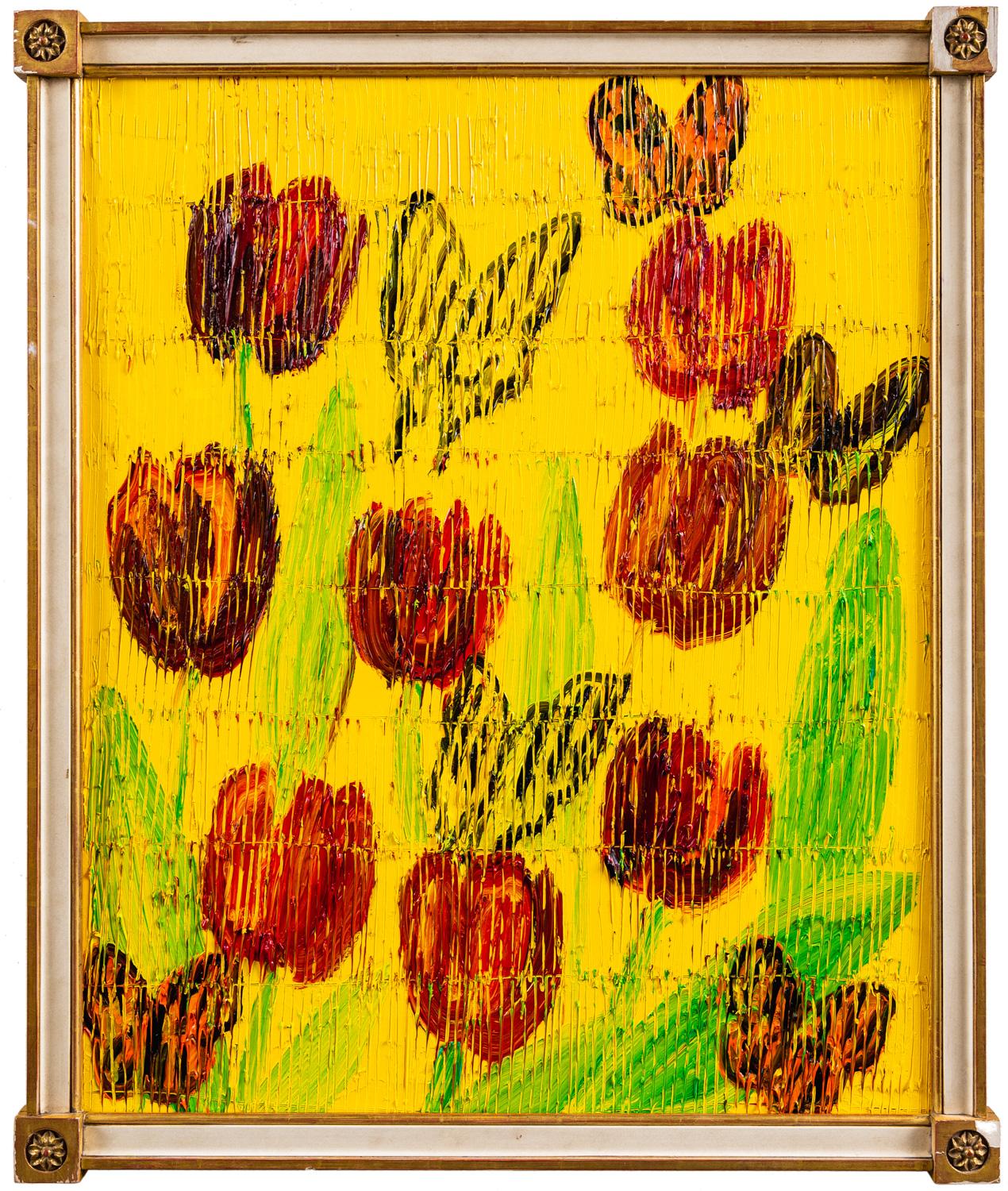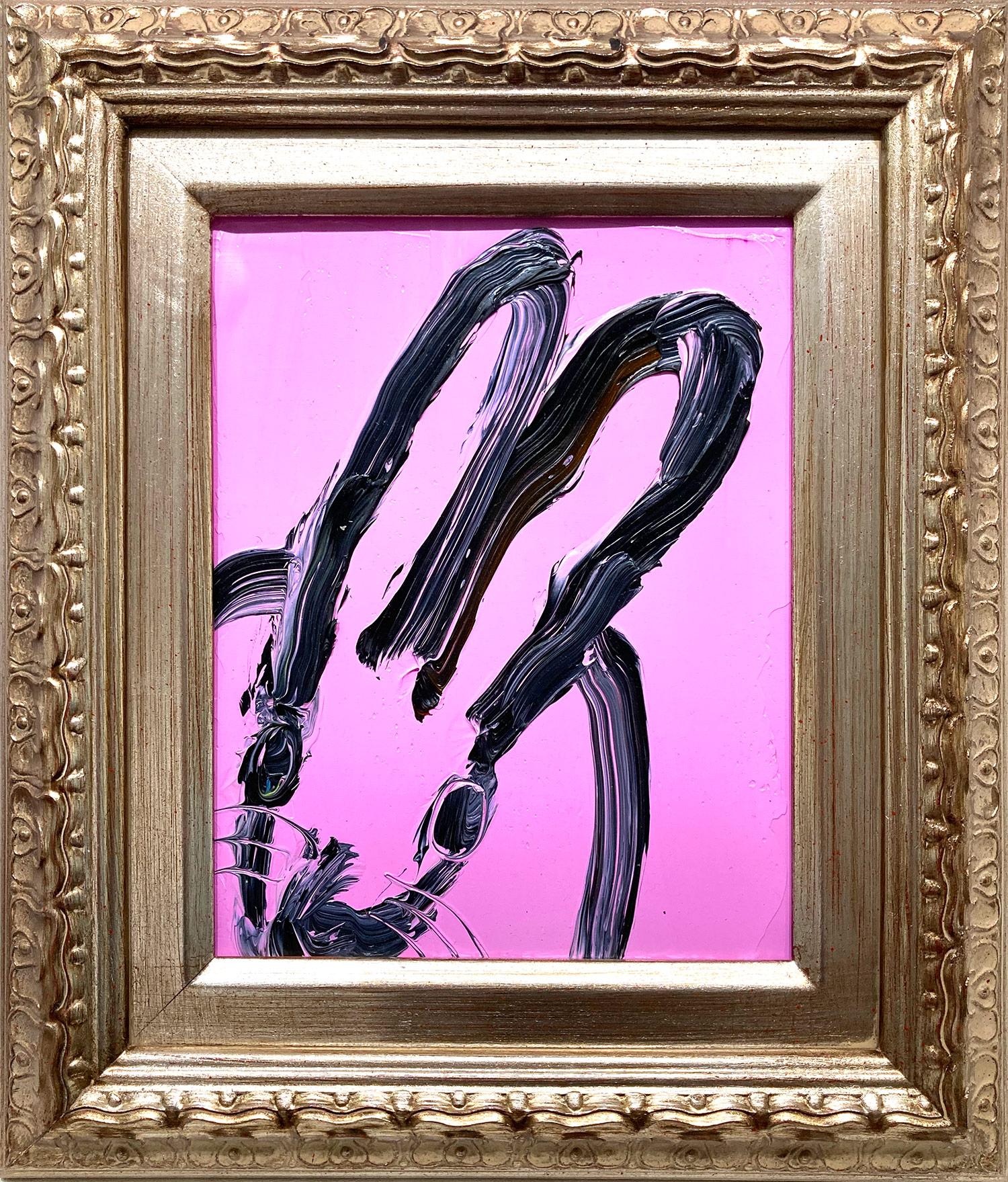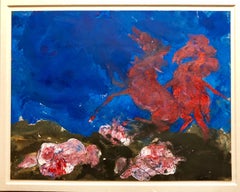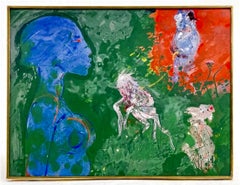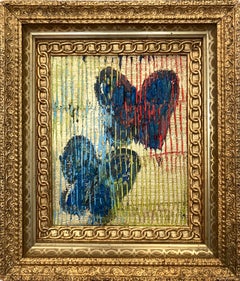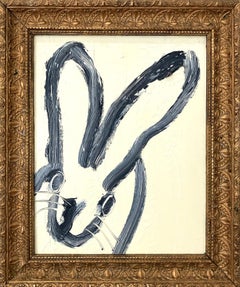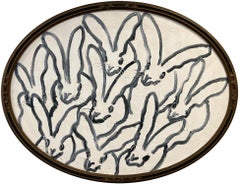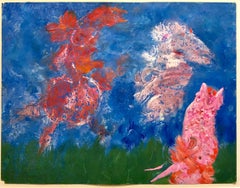
American Neo Expressionist "Wild Horses" Modernist Oil Painting
View Similar Items
Want more images or videos?
Request additional images or videos from the seller
1 of 10
Robert BeauchampAmerican Neo Expressionist "Wild Horses" Modernist Oil Painting
About the Item
- Creator:Robert Beauchamp (1923 - 1995, American)
- Dimensions:Height: 26.5 in (67.31 cm)Width: 33 in (83.82 cm)
- Medium:
- Movement & Style:
- Period:
- Condition:size includes mat. mounted to matting small studio losses to corners. in good studio condition.
- Gallery Location:Surfside, FL
- Reference Number:1stDibs: LU3823013943
About the Seller
4.9
Platinum Seller
These expertly vetted sellers are 1stDibs' most experienced sellers and are rated highest by our customers.
Established in 1995
1stDibs seller since 2014
1,550 sales on 1stDibs
Typical response time: 1 hour
More From This SellerView All
- American Neo Expressionist "Wild Horses" Modernist Oil PaintingBy Robert BeauchampLocated in Surfside, FLRobert Beauchamp (1923 – March 1995) was an American figurative painter and arts educator. Beauchamp's paintings and drawings are known for depicting dramatic creatures and figures with expressionistic colors. His work was described in the New York Times as being "both frightening and amusing,". He was a Guggenheim Fellow and a student of Hans Hofmann. Robert Beauchamp was born in Denver, Colorado in 1923. He had three brothers and three sisters, and the children were orphaned by both parents by the time Beauchamp was three. The family grew up impoverished due to the Great Depression, living in a community house with other families. As a child he dabbled in art but it wasn't until high school that he began taking art classes. When not creating art he also played sports; football and basketball, and enjoyed chemistry and geology. He was told he was good at drawing, and replaced study hall classes with art classes, receiving instruction and inspiration from a Welsh teacher named R. Idris Thomas. While in high school Beauchamp would go, every Monday, to the public library and a local museum where he would read books about art; specifically French painting, as assigned by Thomas. Beauchamp absorbed the tenets of European Modernism and American Abstract Expressionism—with which he eventually broke. While abstraction, with its focus on color and form, underlies his compositions, he filled canvas and paper with psychologically acute portraits of himself and others, nudes, animals, and objects of all kinds. Beauchamp would spend upwards of four hours a day in the art room and eventually won the Carter Memorial Prize, which provided a scholarship to the Colorado Springs Fine Arts Center. At Colorado Springs he studied under Boardman Robinson, painting landscapes in nature. Beauchamp eventually joined the Navy and then returned to Colorado Springs to continue his studies. Traveling the world as an Armed Guard, he spent a year and a half at sea and the rest of the three years in San Francisco. Seeking to make money, and to follow his love for a girl, Beauchamp decided to attend Cranbrook Academy of Art from 1947–1948. There he studied pottery, believing one could "make more money selling pots than you could selling paintings." He described his experience at Cranbrook as intimidating and claustrophobic, and eventually switched to sculpture before switching to painting. Beauchamp moved to New York City in the early 1950s and was involved in the Tenth Street galleries, which provided outlets for more experimental artists and the second generation of abstract expressionists. Despite his involvement with 10th Street and friendships with abstract artists, abstract art never interested in him. He showed at numerous galleries in New York and Provincetown, socializing with gallery owners, artists and collectors. His first exhibition was at the Tanager Gallery in New York, he also showed during the 1950s at the Hansa Gallery. In New York and Provincetown he studied under Hans Hofmann Eventually he felt that abstract expressionism became dull and stalemated. During the 1960s he showed at the Green Gallery. C. 1960 he was awarded a Fulbright Award allowing him to travel to La Romola, Italy. He traveled frequently to cities such as Rome and worked constantly. Beauchamp returned to the states and lived in Provincetown at Walter Gutman's house, who awarded Beauchamp a grant. That year he met his future wife, Nadine Valenti, whom he married in 1967. Beauchamp taught at a variety of schools during his lifetime including Brooklyn College, School of Visual Arts, Cooper Union and the Art Students League of New York during the last fifteen years of his life. Beauchamp described his drawings as painterly, seeking the spontaneity in an image. He would develop a drawing then a painting, and vice versa. His heavily impastoed paintings, often described as sculptures themselves, came from the pouring of paint from a can, with little planning and constant evolution in the medium upon the canvas. He preferred little planning to his creations, believing that an artists work would become stale and repetitive with constant planning. He also created large scale works, at times 70 inches long. Beauchamp had little intention of ever selling his large works, preferring to create them due to the slow and intense experience he received from the process. The large drawings he created on the floor, and the smaller works were created on a table. Paintings were created on either the floor or wall and he described his painting process as "splattering", "pushing the paint around," and sponging. Animals often appear in his paintings, despite a dislike for domestic animals outside of his artistic creations. He called the characters in his paintings as Beauchamps. Some Beauchamps hold meaning, with Beauchamp rarely sharing the meaning behind the symbols and characters. He made up the creatures himself, seeking to emphasize the character of each. In 2006 the University of Massachusetts Amherst College of Visual & Performing Arts hosted an exhibition of Beauchamp's pieces from the 1960s, curators stated that Beauchamp's work: "effortlessly blends innovative style elements with narrative, descriptive images. One senses equal enjoyment in the manipulation of, and interaction with, color and paint, and the often sudden and unexpected presence of a wasp or a lump of sugar." included in the important exhibit "Twelve New York Painters." New York: David Findlay Jr. Fine Art with Mary Abbott, Alcopley, Robert Beauchamp, Byron Browne, Charles Cajori, Jim Forsberg, Carl Heidenreich, Angelo Ippolito, Emily Mason, Robert Natkin, Robert Richenburg and Nina Tryggvadottir...Category
20th Century Neo-Expressionist Abstract Paintings
MaterialsPaper, Oil
- American Neo Expressionist "Wild Horses" Modernist Oil PaintingBy Robert BeauchampLocated in Surfside, FLSigned lower left. Robert Beauchamp (1923 – March 1995) was an American figurative painter and arts educator. Beauchamp's paintings and drawings are known for depicting dramatic creatures and figures with expressionistic colors. His work was described in the New York Times as being "both frightening and amusing,". He was a Guggenheim Fellow and a student of Hans Hofmann. Robert Beauchamp was born in Denver, Colorado in 1923. He had three brothers and three sisters, and the children were orphaned by both parents by the time Beauchamp was three. The family grew up impoverished due to the Great Depression, living in a community house with other families. As a child he dabbled in art but it wasn't until high school that he began taking art classes. When not creating art he also played sports; football and basketball, and enjoyed chemistry and geology. He was told he was good at drawing, and replaced study hall classes with art classes, receiving instruction and inspiration from a Welsh teacher named R. Idris Thomas. While in high school Beauchamp would go, every Monday, to the public library and a local museum where he would read books about art; specifically French painting, as assigned by Thomas. Beauchamp absorbed the tenets of European Modernism and American Abstract Expressionism—with which he eventually broke. While abstraction, with its focus on color and form, underlies his compositions, he filled canvas and paper with psychologically acute portraits of himself and others, nudes, animals, and objects of all kinds. Beauchamp would spend upwards of four hours a day in the art room and eventually won the Carter Memorial Prize, which provided a scholarship to the Colorado Springs Fine Arts Center. At Colorado Springs he studied under Boardman Robinson, painting landscapes in nature. Beauchamp eventually joined the Navy and then returned to Colorado Springs to continue his studies. Traveling the world as an Armed Guard, he spent a year and a half at sea and the rest of the three years in San Francisco. Seeking to make money, and to follow his love for a girl, Beauchamp decided to attend Cranbrook Academy of Art from 1947–1948. There he studied pottery, believing one could "make more money selling pots than you could selling paintings." He described his experience at Cranbrook as intimidating and claustrophobic, and eventually switched to sculpture before switching to painting. Beauchamp moved to New York City in the early 1950s and was involved in the Tenth Street galleries, which provided outlets for more experimental artists and the second generation of abstract expressionists. Despite his involvement with 10th Street and friendships with abstract artists, abstract art never interested in him. He showed at numerous galleries in New York and Provincetown, socializing with gallery owners, artists and collectors. His first exhibition was at the Tanager Gallery in New York, he also showed during the 1950s at the Hansa Gallery. In New York and Provincetown he studied under Hans Hofmann Eventually he felt that abstract expressionism became dull and stalemated. During the 1960s he showed at the Green Gallery. C. 1960 he was awarded a Fulbright Award allowing him to travel to La Romola, Italy. He traveled frequently to cities such as Rome and worked constantly. Beauchamp returned to the states and lived in Provincetown at Walter Gutman's house, who awarded Beauchamp a grant. That year he met his future wife, Nadine Valenti, whom he married in 1967. Beauchamp taught at a variety of schools during his lifetime including Brooklyn College, School of Visual Arts, Cooper Union and the Art Students League of New York during the last fifteen years of his life. Beauchamp described his drawings as painterly, seeking the spontaneity in an image. He would develop a drawing then a painting, and vice versa. His heavily impastoed paintings, often described as sculptures themselves, came from the pouring of paint from a can, with little planning and constant evolution in the medium upon the canvas. He preferred little planning to his creations, believing that an artists work would become stale and repetitive with constant planning. He also created large scale works, at times 70 inches long. Beauchamp had little intention of ever selling his large works, preferring to create them due to the slow and intense experience he received from the process. The large drawings he created on the floor, and the smaller works were created on a table. Paintings were created on either the floor or wall and he described his painting process as "splattering", "pushing the paint around," and sponging. Animals often appear in his paintings, despite a dislike for domestic animals outside of his artistic creations. He called the characters in his paintings as Beauchamps. Some Beauchamps hold meaning, with Beauchamp rarely sharing the meaning behind the symbols and characters. He made up the creatures himself, seeking to emphasize the character of each. In 2006 the University of Massachusetts Amherst College of Visual & Performing Arts hosted an exhibition of Beauchamp's pieces from the 1960s, curators stated that Beauchamp's work: "effortlessly blends innovative style elements with narrative, descriptive images. One senses equal enjoyment in the manipulation of, and interaction with, color and paint, and the often sudden and unexpected presence of a wasp or a lump of sugar." included in the important exhibit "Twelve New York Painters." New York: David Findlay Jr. Fine Art with Mary Abbott, Alcopley, Robert Beauchamp, Byron Browne, Charles Cajori, Jim Forsberg, Carl Heidenreich, Angelo Ippolito, Emily Mason, Robert Natkin, Robert Richenburg and Nina Tryggvadottir...Category
20th Century Neo-Expressionist Abstract Paintings
MaterialsPaper, Oil
- American Neo Expressionist Woman with Monkeys Abstract Modernist Oil PaintingBy Robert BeauchampLocated in Surfside, FLRobert Beauchamp, American (1923-1995) Untitled Hand signed lower right, titled verso. MIxed media oil painting on heavy art paper sight: 22 3/4 x 29 1/2 inches frame dimensions: 23 1/4 x 30 1/4 x 1 1/4 inches, metal frame with glazing Provenance: Private Collection. Frame inscribed 'Property of AT&T' Bears label from their corporate art collection. Robert Beauchamp (1923 – March 1995) was an American figurative painter and arts educator. Beauchamp's paintings and drawings are known for depicting dramatic creatures and figures with expressionistic colors. His work was described in the New York Times as being "both frightening and amusing,". He was a Guggenheim Fellow and a student of Hans Hofmann. Robert Beauchamp was born in Denver, Colorado in 1923. He had three brothers and three sisters, and the children were orphaned by both parents by the time Beauchamp was three. The family grew up impoverished due to the Great Depression, living in a community house with other families. As a child he dabbled in art but it wasn't until high school that he began taking art classes. When not creating art he also played sports; football and basketball, and enjoyed chemistry and geology. He was told he was good at drawing, and replaced study hall classes with art classes, receiving instruction and inspiration from a Welsh teacher named R. Idris Thomas. While in high school Beauchamp would go, every Monday, to the public library and a local museum where he would read books about art; specifically French painting, as assigned by Thomas. Beauchamp absorbed the tenets of European Modernism and American Abstract Expressionism—with which he eventually broke. While abstraction, with its focus on color and form, underlies his compositions, he filled canvas and paper with psychologically acute portraits of himself and others, nudes, animals, and objects of all kinds. Beauchamp would spend upwards of four hours a day in the art room and eventually won the Carter Memorial Prize, which provided a scholarship to the Colorado Springs Fine Arts Center. At Colorado Springs he studied under Boardman Robinson, painting landscapes in nature. Beauchamp eventually joined the Navy and then returned to Colorado Springs to continue his studies. Traveling the world as an Armed Guard, he spent a year and a half at sea and the rest of the three years in San Francisco. Seeking to make money, and to follow his love for a girl, Beauchamp decided to attend Cranbrook Academy of Art from 1947–1948. There he studied pottery, believing one could "make more money selling pots than you could selling paintings." He described his experience at Cranbrook as intimidating and claustrophobic, and eventually switched to sculpture before switching to painting. Beauchamp moved to New York City in the early 1950s and was involved in the Tenth Street galleries, which provided outlets for more experimental artists and the second generation of abstract expressionists. Despite his involvement with 10th Street and friendships with abstract artists, abstract art never interested in him. He showed at numerous galleries in New York and Provincetown, socializing with gallery owners, artists and collectors. His first exhibition was at the Tanager Gallery in New York, he also showed during the 1950s at the Hansa Gallery. In New York and Provincetown he studied under Hans Hofmann Eventually he felt that abstract expressionism became dull and stalemated. During the 1960s he showed at the Green Gallery. C. 1960 he was awarded a Fulbright Award allowing him to travel to La Romola, Italy. He traveled frequently to cities such as Rome and worked constantly. Beauchamp returned to the states and lived in Provincetown at Walter Gutman...Category
20th Century Neo-Expressionist Abstract Paintings
MaterialsPaper, Oil
- American Neo Expressionist Woman with Camels Abstract Modernist Oil PaintingBy Robert BeauchampLocated in Surfside, FLHand signed lower right, titled verso. Blue Woman with Seated Camels MIxed media oil painting on heavy art paper Robert Beauchamp (1923 – March 1995) was an American figurative painter and arts educator. Beauchamp's paintings and drawings are known for depicting dramatic creatures and figures with expressionistic colors. His work was described in the New York Times as being "both frightening and amusing,". He was a Guggenheim Fellow and a student of Hans Hofmann. Robert Beauchamp was born in Denver, Colorado in 1923. He had three brothers and three sisters, and the children were orphaned by both parents by the time Beauchamp was three. The family grew up impoverished due to the Great Depression, living in a community house with other families. As a child he dabbled in art but it wasn't until high school that he began taking art classes. When not creating art he also played sports; football and basketball, and enjoyed chemistry and geology. He was told he was good at drawing, and replaced study hall classes with art classes, receiving instruction and inspiration from a Welsh teacher named R. Idris Thomas. While in high school Beauchamp would go, every Monday, to the public library and a local museum where he would read books about art; specifically French painting, as assigned by Thomas. Beauchamp absorbed the tenets of European Modernism and American Abstract Expressionism—with which he eventually broke. While abstraction, with its focus on color and form, underlies his compositions, he filled canvas and paper with psychologically acute portraits of himself and others, nudes, animals, and objects of all kinds. Beauchamp would spend upwards of four hours a day in the art room and eventually won the Carter Memorial Prize, which provided a scholarship to the Colorado Springs Fine Arts Center. At Colorado Springs he studied under Boardman Robinson, painting landscapes in nature. Beauchamp eventually joined the Navy and then returned to Colorado Springs to continue his studies. Traveling the world as an Armed Guard, he spent a year and a half at sea and the rest of the three years in San Francisco. Seeking to make money, and to follow his love for a girl, Beauchamp decided to attend Cranbrook Academy of Art from 1947–1948. There he studied pottery, believing one could "make more money selling pots than you could selling paintings." He described his experience at Cranbrook as intimidating and claustrophobic, and eventually switched to sculpture before switching to painting. Beauchamp moved to New York City in the early 1950s and was involved in the Tenth Street galleries, which provided outlets for more experimental artists and the second generation of abstract expressionists. Despite his involvement with 10th Street and friendships with abstract artists, abstract art never interested in him. He showed at numerous galleries in New York and Provincetown, socializing with gallery owners, artists and collectors. His first exhibition was at the Tanager Gallery in New York, he also showed during the 1950s at the Hansa Gallery. In New York and Provincetown he studied under Hans Hofmann Eventually he felt that abstract expressionism became dull and stalemated. During the 1960s he showed at the Green Gallery. C. 1960 he was awarded a Fulbright Award allowing him to travel to La Romola, Italy. He traveled frequently to cities such as Rome and worked constantly. Beauchamp returned to the states and lived in Provincetown at Walter Gutman...Category
20th Century Neo-Expressionist Abstract Paintings
MaterialsPaper, Oil
- Large Modernist French Abstract Expressionist Colorful Bird Painting Roger LersyBy Roger LersyLocated in Surfside, FLRoger Lersy, French (1920 - 2004) Oil on canvas Signed, R. Lersy, dated 1961 lower right Measuring 35 X 31 Matted and framed. sight 26 X 21.5 Roger Lersy was born in Paris, France 1920, in the rough neighborhood surrounding Place Pigalle. His youth was marked by extreme poverty. Lersy studied art and music at the École des Arts Apppliqués. He was a painter, lithographer and musician-composer He belongs to the École de Paris and was a member in the movement of the Young Painting. By 1946, when he first exhibited in Paris, Lersy became one of the founders of the School of Paris’ New Graphic School. Lersy received the Prix des Amateurs d’Art in 1953, the Shell Prize in 1954 and the Grand Prize of the City of Marseilles in 1953. Lersy could be defined as a Baroque expressionist. For Bernard Dorival, Roger Lersy is along with Gabriel Dauchot, Jean Commère and Raymond Guerrier among "the most noted champions of this expressionism which is part of the continuation of Bernard Buffet's miserabilism". Famous works: New Year's Eve , Aubusson tapestry of the Manufacture des Gobelins , Permanent Mission of France to the United Nations , One Dag Hammarskjöld Plaza , New York . Venice , bridges , watercolor, 1963 (theme of the Roger Lersy exhibition, Chicago). The poppy , original lithograph, Imprimerie Bellini, 1978, collection of the Cabinet des estampes , BNF . Still life at the pedestal table , oil on canvas, Jonzac town hall. Lohengrin , oil on canvas, Versailles Administrative Court of Appeal. Portrait of the painter Tony Agostini , drawing. Series Eiffel Tower. Stained glass: Saint-Laurent Church, Longlaville ( Meurthe-et-Moselle ), 29 stained glass windows. Musical works: Stained glasses for clarinet , saxophone, cello and percussion , creation in the church of Longlaville, 1972. Three pieces for two waves Martenot : 1. Scum of dream, 2. Scare and jubilation. Malicious connivance, sheet music Editions A. Leduc, Paris, 1979. Work for trumpet and piano , published by Éditions G. Billaudot, Paris, 1984. Five pieces for piano , scores published by G. Billaudot, Paris, 1989. Five preludes for piano and alto saxophone , scores at Éditions Combre, premiere at Flâneries musicales de Reims , 1993. In memory of Chagall , piece for flute and percussion , recording of Duo Hyksos (Henri Tournier, flute and Michel Gastaud, percussion) in 1995. Preface in black and yellow for horn and piano , score at Éditions Combre, Arc-en-ciel collection, 2000. Soundtracks: Diatomées Note 4 , 19 , film by Jean Painlevé...Category
1960s Abstract Expressionist Abstract Paintings
MaterialsOil, Acrylic, Canvas
- Mod Abstract Expressionist Modernist Oil Painting Dog Drawing Edward AvedisianBy Edward AvedisianLocated in Surfside, FLEdward Avedisian ( 1936-2007 ) 7.5 X 5.75 Oil paint on wood panel This is not signed on front. It bears his name verso. Provenance: Hudson, N.Y. estate of noted Art Collector Albert...Category
1960s Abstract Expressionist Animal Paintings
MaterialsOil, Wood Panel, Graphite
You May Also Like
- "Morpho II" Multicolor Butterflies on Gold Background Oil on Wood with ScoringBy Hunt SlonemLocated in New York, NYA wonderful composition of one of Slonem's most iconic subjects, Butterflies. This piece depicts two delicate butterflies in ascension placed in a wonderful golden landscape with blue, red and yellow background. Slonem traces his famous crosshatch details throughout the piece, with thick use of paint and elegant accents. Inspired by nature and a genuine love for animals, Slonem's paintings encompass unique inspirations drawn from the world. While viewing this piece in person, it is as if we are surrounded by beauty and encased effortlessly in a golden seascape. This painting invites us to celebrate nature and the simplicity of flight from the elegant world of the butterfly. This painting is signed and dated by the artist on verso and it comes housed in a simple vintage frame...Category
2010s Neo-Expressionist Animal Paintings
MaterialsOil, Wood Panel
- "Eternal" Black Bunny on Pale Green Background Oil Painting on Wood PanelBy Hunt SlonemLocated in New York, NYA wonderful composition of one of Slonem's most iconic subjects, Bunnies. This piece depicts a gestural figure of a black bunny on a light pale green background with thick use of pai...Category
2010s Neo-Expressionist Animal Paintings
MaterialsOil, Wood Panel
- "Bunnys Tondo" Black Outlined Bunnies on White Background in Oval Antique FrameBy Hunt SlonemLocated in New York, NYA wonderful composition of one of Slonem's most iconic subjects, Bunnies. This piece depicts gestural figures of Bunnies against a white background. The color white symbolizes safety...Category
2010s Neo-Expressionist Animal Paintings
MaterialsOil, Board
- "Flip" Black Bunny on Lavender Purple Background Oil Painting on Wood PanelBy Hunt SlonemLocated in New York, NYA wonderful composition of one of Slonem's most iconic subjects, Bunnies. This piece depicts a gestural figure of a black bunny on a Purple Lavender background with thick use of pain...Category
2010s Neo-Expressionist Animal Paintings
MaterialsOil, Wood Panel
- "Blade" Black Outline Bunny on a Deep Green Background Oil Painting Wood PanelBy Hunt SlonemLocated in New York, NYA wonderful composition of one of Slonem's most iconic subjects, Bunnies. This piece depicts a gestural figure of a black bunny on a green background with thick use of paint. Inspire...Category
2010s Neo-Expressionist Animal Paintings
MaterialsOil, Wood Panel
- "Totem Assumption" Black Bunnies on Multicolored Background with Gold and SilverBy Hunt SlonemLocated in New York, NYA stunning composition of one of Slonem's most iconic subjects, Bunnies. This piece depicts gestural figures of Bunnies against a multicolored background with gold and silver. Slonem traces these bunnies with thick black paint. Inspired by nature and a genuine love for animals, Slonem's paintings encompass unique inspirations drawn from the world. While viewing this piece in person, it is as if we are surrounded by elegance effortlessly, dazzled by the sparkle and enchanted with the charm of the Rabbit which symbolizes good fortune. This painting invites us to celebrate nature and the simplicity of form from the inspiring world of the Rabbit. The painting is signed and dated on verso on thick gallery wrap canvas. Art measures 70 x 50 inches Hunt Slonem was born in 1951 in Kittery, York County Maine. He is a renowned American painter, sculptor, and printmaker. Slonem is best known for his abstract depictions of animals, specifically Birds, Butterflies, and Bunnies. His whimsicality has captured the hearts of many across the globe, enchanting us all with a phenomenal power to elevate and inspire effortlessly. His works can best be described as monumental and uplifting as these forces certainly are the cornerstones of his inspiration. His pieces draw upon a spiritual connection celebrating nature, animals, and history. This bond stems from a love of exotic birds, as he has over 90 of them in his studio, painting them from life almost every day. His travels around the world since a young age has brought much passion for landscapes, as his father was in the Navy, living in Hawaii, Nicaragua to Mexico. And lastly, his unique joy in preserving historic homes has brought him to collect over 8 historic properties in the US, realizing too many of the country’s architectural gems have fallen into disrepair, bringing them back to their original beauty while decorating them with genuine antiques and his own creations. Hunt possesses a unique gift, a gift that stretches far beyond his creations in art. Stepping inside his studio is an experience to behold. It is like stepping into a magical world, where you feel anything is possible; similar to the feelings you get when gazing at one of his enchanting paintings. The music of birds echoes and creates the soundtrack while enjoying other treasures placed perfectly in the design of his studio. You can find a family of harps positioned in a centered arrangement, a forest of tropical plants in another, objects and vases situated and resituated, as Slonem is inspired by the decorations arranged almost daily with-in this seemingly endless stretch of space. And that’s not all, there is a collection of antique top hats...Category
2010s Neo-Expressionist Animal Paintings
MaterialsCanvas, Oil
Recently Viewed
View AllMore Ways To Browse
Neo Neo
Early Modernist Painting
American School Abstract Expressionist
Neo Modern
Library Oil Painting
Small Expressionist Paintings
Painting Of Louisiana
Modernist Italian Art
Louisiana Painting
Berkeley Painting
American Modernist Oil Painting
Nature 20th Century America
Call Of The Wild
Robert Evers
Paintings Of Pottery
20th Century Painting Horse
1960s Expressionist Paintings
Pittsburgh Paintings
